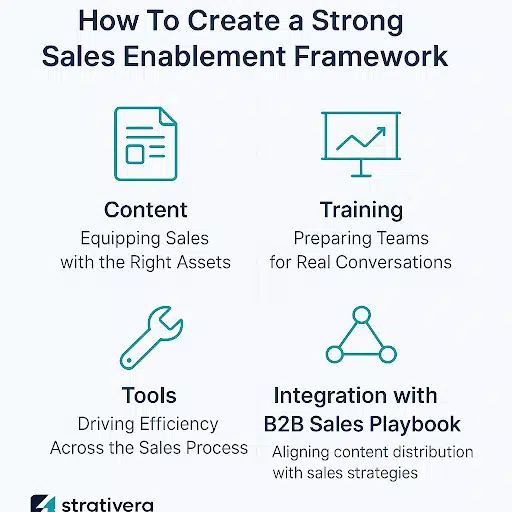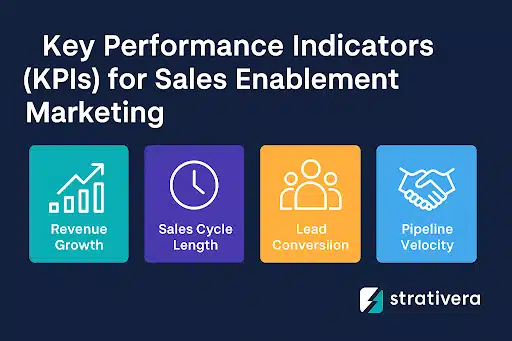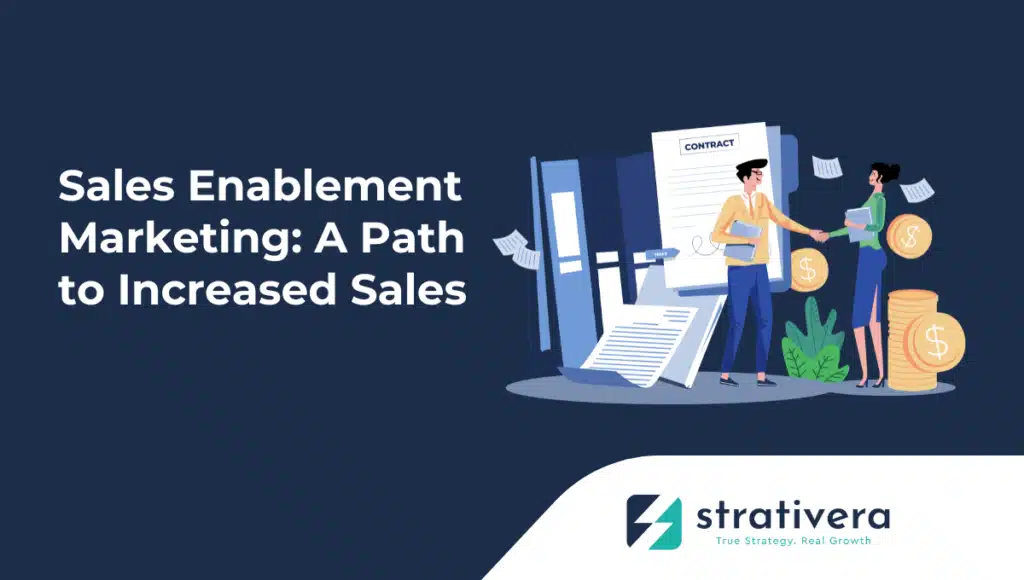Table of Contents
Business expansion needs more than lead generation. The organizations that prosper realize that there must be alignment between the marketing strategies and the sales execution. Growth is achieved through a smooth form of collaboration between the two departments.
According to a report by the Harvard Business Review, businesses that align sales and marketing experience 208 percent higher revenue growth. This confirms that alignment is not optional but must be used to achieve a sustained performance. Business firms with structured approaches provide their sales personnel with confidence and clarity in every customer interaction.
The goal does not exclusively lie in the immediate sales boost but in scalability and efficiency in the long term. The core of this alignment is the sales enablement marketing.
What is Sales Enablement Marketing?
Sales enablement marketing provides sales reps with coherent tools, data, and materials to achieve an effective sale. It gives uniformity in messaging, ensures readiness of reps in discussions, and integrates brand value throughout conversations with buyers.
Forrester Research indicates that companies that use sales enablement approaches can increase sales productivity by 20%. This increase is attributed to access to personalized and location-specific content based on advanced analytics and in-time buyer intelligence. B2B sales enablement is through teams that work smarter and deliver better results.
Predictability and efficiency are essential. Sales enablement marketing at Strativera transforms sellers into trusted advisors by enabling them to align marketing and the sales process, resulting in a higher conversion rate and revenue growth.
How To Create a Strong Sales Enablement Framework

Establishing a robust sales enablement framework begins with recognizing the company’s vision and driving it to meet customer requirements. The components below form the basis of strong enablement and align with a B2B sales playbook to drive consistency throughout the organization.
Content: Equipping Sales with the Right Assets
Content drives meaningful buyer engagement. Sales teams can have an informed conversation by having essential high-quality resources (case studies, playbooks, product sheets). However, without effective enablement, content is likely to be lost or go underutilized.
Content Marketing Institute reports that B2B organizations do not use 60% of the content they create. The reason is poor accessibility or misalignment. A sales enablement framework overcomes this by establishing centralized repositories where applicable content can be retrieved with immediate effect.
With immediate and relevant resources at their fingertips, reps can sell solutions with credibility and enthusiasm to provide customers with the products and services they need to succeed. Efficient content application reduces the sales lifecycle management stages and establishes credibility at each point of contact.
Training: Preparing Teams for Real Conversations
Training converts theoretical skills to practical skills. The sales representative should continually learn to deal with rejections, buyer psychology, and changes in competition. Structured training will go a long way in closing the gap between sales and marketing objectives.
According to a Salesforce State of Sales report, there is a 2.8x chance that high-performing teams will receive regular training. Making the connection between training programs and sales lifecycle management enables teams to know what should be said, when it should be said, and how to interact.
Sales teams can be transformed into trusted advisors by attending scenario-based workshops, practicing through coaching, and undergoing consistent assessments. Ongoing enablement leads to efficiency, shortened ramp-up, and enhanced cooperation with marketing to boost win rates, supporting business execution and growth.
Tools: Driving Efficiency Across the Sales Process
Technology leads to uniformity and performance in the sales cycle. Tools accompanying the B2B sales playbook help guide reps to follow established systems. They also make sales pipeline management very easy and enhance productivity. Gartner states that improved forecast accuracy can be achieved by 15% in organizations that utilize advanced sales technologies. Key tools include:
-
- CRM Systems: Share centralized data, keep customer interactions recorded, and maintain visibility throughout the pipeline to facilitate accurate forecasts and seamless handoffs.
-
- Content Management Platforms: Consolidate marketing assets and guarantee that reps have access to the most up-to-date resources in real time, while harmonizing customer dialogue with corporate messaging.
-
- Sales Engagement Tools: Automate email sequences, call tracking, and follow-ups, and you will spend less time on these tasks while still maintaining a personalized approach.
-
- Analytics Dashboards: Monitor engagement, forecast pipeline speed, and measure sales enablement metrics, which can generate actionable insights that enhance sales performance.
-
- Training Platforms: Provide continuous enablement with tracking, completion, and improvement concerning key sales enablement KPIs.
Integration with B2B Sales Playbook
Integration with a B2B sales playbook will help sales representatives adhere to structured, proven methods of approaching prospects. Playbooks make the team consistent by providing repeatable strategies, messaging instructions, and tactical processes.
A report by McKinsey & Company showed that companies that followed structured playbooks saw an increase in the rate of sales productivity by over 15 percent. It is this reduction of ambiguity and assisting reps in what works that leads to this growth.
The sales enablement framework, alongside the playbook, will enable marketing to match content with the sales execution. This will provide consistency to buyers and sellers, and will have a roadmap that takes them through all the phases of Sales Lifecycle Management.
Key Sales Enablement KPIs and Metrics to Track
Measuring outcomes ensures teams refine their approach. Tracking sales enablement KPIs and sales enablement benchmarks can help you identify areas for improvement and those that are not making significant progress.

Key Performance Indicators (KPIs) for Sales Enablement Marketing
-
- Content Utilization Rate: Tracks the frequency at which reps utilize the content supplied. A high percentage means that marketing efforts and sales requirements are very aligned.
-
- Training Completion Rate: Tracks the number of sales reps who complete training. Higher completion rates are an indication of greater readiness and better capacity to approach customers.
-
- Lead-to-Customer Conversion: Look at the percentage of marketing-qualified leads that close. This KPI identifies the impact of enablement on measurable revenue growth.
-
- Average Sales Cycle Length: Tracks time to close. Shorter cycles are symbolic of efficient sales enablement marketing strategies.
-
- Win Rate Improvement: The metric evaluates the number of deals closed against the number of opportunities. Enhanced win rates prove the successful integration of the enablement efforts.
Sales Enablement Metrics and Benchmarks
-
- Engagement with B2B Sales Playbook: Ensures that documented processes are met. Better engagement will lead to a better fit with organizational strategies.
-
- Pipeline Velocity: Determines the pace of opportunities through stages. Increasing velocity yields growing values of signals in sales pipeline management.
-
- Content ROI: Evaluates revenue directly impacted by content. High ROI can prove the effectiveness of marketing in the sales performance of the organization.
-
- Sales Rep Ramp-Up Time: It takes time to hire new workers to be productive. Organized BDR program training eliminates delay.
-
- Customer Retention Rate: Looks at post-sale loyalty. Proper retention attests to the role of enablement in addition to acquisition.
How Sales Enablement Supports BDR and SDR Teams
Sales enablement marketing is critical to developing frontline functions such as BDR and SDR functions. These positions can serve as the initial point of contact with customers. Enablement empowers them with structure and resources.
Strengthening the BDR Program
An organized BDR program makes prospecting activities organized and successful. BDRs can contact leads with accuracy and repetition as the scripts and the content are centralized.
Enablement strategies also reduce wasted time. Access to sales enablement framework tools is critical in guaranteeing that BDRs can monitor their activities, effectively qualify leads, and efficiently transition them to the account executives.
Enhancing SDR Effectiveness
Lead routing best practices implementation eliminates delays in prospect assignment. Fast routing will also mean that no lead is wasted because it is not acted upon quickly enough.
Enablement systems provide clarity in assigning ownership. This enhances interconnection among SDRs, BDRs, and account executives, facilitating a seamless buyer experience and more successful conversion.
Enabling Sales Lifecycle Management
Teams achieve visibility of all stages of the sales process through the use of sales lifecycle management. Consistency prevents confusion and builds predictable outcomes.
Enablement ensures each team member knows their role. Formalized processes lead to increased teamwork, minimize mistakes, and improve the speed at which deals shift to closure.
Aligning Teams for Growth
Organizations that embrace sales enablement marketing can transform sales and marketing into a growth engine by integrating them into a cohesive process. This positioning reduces the chances of losses, cycle time, and improves customer journeys.
The way forward involves regular training, well-organized content delivery, and the effective use of technologies. Businesses ready to achieve scalable growth should act now. Contact Strativera for Customized Sales Enablement!
FAQs: Sales Enablement Marketing
What is Sales Enablement Marketing, and How Does It Work?
It delivers methodized resources, training, and content that equip sales teams to engage prospects successfully and generate results that can be measured.
How Can Strativera Help Implement a Sales Enablement Framework?
Strativera implements personalised solutions, trains teams, and implements scalable tools to establish a repeatable sales enablement platform.
What Are the Most Important Sales Enablement KPIs to Track?
Some of the most relevant KPIs are the win rate improvement, content utilization, training completion, conversion rates, and average length of the sales cycle.
How Does Strativera Support B2B Sales Enablement Strategies?
Strativera enables the transformation of B2B sales, increasing sales pipeline velocity and collaboration across teams with sophisticated insights and coaching.
What Are the Essential Sales Enablement Metrics for B2B Teams?
Examples of core metrics include content ROI, customer retention, pipeline velocity, and the ramp-up time of sales reps.

